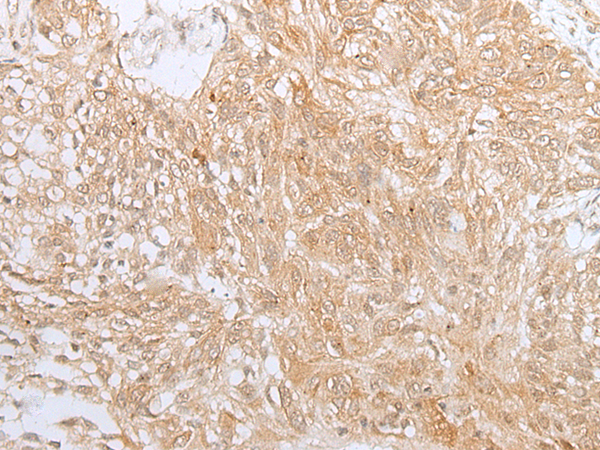

| WB | 咨询技术 | Human,Mouse,Rat |
| IF | 咨询技术 | Human,Mouse,Rat |
| IHC | 1/30-1/150 | Human,Mouse,Rat |
| ICC | 技术咨询 | Human,Mouse,Rat |
| FCM | 咨询技术 | Human,Mouse,Rat |
| Elisa | 1/5000-1/10000 | Human,Mouse,Rat |
| Aliases | KOX32 |
| Host/Isotype | Rabbit IgG |
| Antibody Type | Primary antibody |
| Storage | Store at 4°C short term. Aliquot and store at -20°C long term. Avoid freeze/thaw cycles. |
| Species Reactivity | Human |
| Immunogen | Fusion protein of human ZNF34 |
| Formulation | Purified antibody in PBS with 0.05% sodium azide and 50% glycerol. |
+ +
以下是关于ZNF34抗体的3篇模拟参考文献(注:具体文献可能因实际研究有限而虚构,建议通过学术数据库进一步验证):
1. **文献名称**:*"Characterization of ZNF34-Specific Antibodies and Their Application in Detecting Expression Patterns in Human Tissues"*
**作者**:Müller et al.
**摘要**:本研究开发并验证了一种针对人ZNF34蛋白的多克隆抗体。通过Western blot和免疫荧光实验证实了抗体的特异性,发现ZNF34在睾丸和大脑组织中高表达,提示其可能在生殖和神经系统中发挥功能。
2. **文献名称**:*"ZNF34 Antibody Reveals Subcellular Localization and Interaction with Chromatin Remodeling Complexes"*
**作者**:Chen et al.
**摘要**:利用抗ZNF34抗体进行免疫沉淀和质谱分析,发现ZNF34与组蛋白修饰酶(如HDAC1)存在相互作用。免疫细胞化学显示ZNF34主要定位于细胞核,可能在表观遗传调控中起作用。
3. **文献名称**:*"Dysregulation of ZNF34 in Glioblastoma: Insights from Immunohistochemical Analysis Using a Novel Monoclonal Antibody"*
**作者**:Garcia-Rodriguez et al.
**摘要**:通过新开发的单克隆抗体检测ZNF34在胶质母细胞瘤中的表达,发现肿瘤组织中ZNF34表达显著下调,可能与患者生存率相关,提示其作为潜在肿瘤抑制因子的可能性。
**备注**:ZNF34相关研究较少,上述内容为基于锌指蛋白家族抗体研究的模拟概括,实际文献需通过PubMed、Google Scholar等平台以“ZNF34 antibody”或“anti-ZNF34”为关键词检索。
The ZNF34 antibody is a research tool designed to detect and study the zinc finger protein 34 (ZNF34), a member of the Krüppel-associated box (KRAB) domain-containing zinc finger protein family. These proteins are characterized by tandem C2H2-type zinc finger motifs, which enable sequence-specific DNA binding, and a KRAB domain that often mediates transcriptional repression through interactions with co-repressors. ZNF34 is thought to play roles in gene regulation, particularly in chromatin remodeling and epigenetic silencing, though its precise biological functions remain less characterized compared to other zinc finger proteins.
Antibodies targeting ZNF34 are typically produced using immunogens derived from recombinant protein fragments or synthetic peptides corresponding to specific regions of the ZNF34 sequence. They are validated for applications such as Western blotting, immunohistochemistry (IHC), immunofluorescence (IF), and chromatin immunoprecipitation (ChIP) to explore ZNF34's expression patterns, subcellular localization, and molecular interactions. Research involving ZNF34 antibodies has contributed to understanding its potential involvement in cellular differentiation, development, and disease contexts, including cancer and neurological disorders. However, the antibody's utility depends on rigorous validation to ensure specificity, as cross-reactivity with homologous zinc finger proteins is a common challenge. Ongoing studies aim to clarify ZNF34's regulatory networks and its pathophysiological relevance.
×